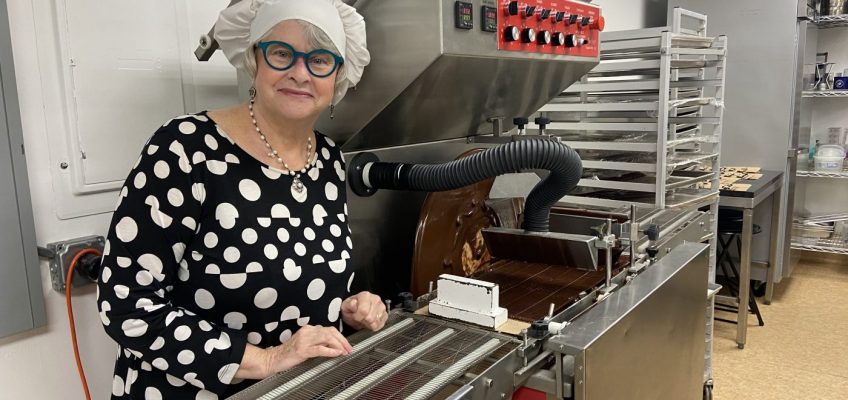Somewhat unexpectedly — including to them — the three dominant women chocolatiers in the East Metro share a similar trajectory.
Mary Leonard, Robyn Dochterman and Susan Brown all feel lifelong connections to food but began their lives in other spheres, and each found her way back to chocolate as a midlife career change.
Leonard started Chocolat Celeste in 2001. Dochterman started St. Croix Chocolate Company in 2010. Brown started Mademoiselle Miel in 2011.
Now, each of their chocolate companies are in their adolescence, and greater St. Paul’s dames of chocolate are using the treat to bring people closer together and encourage us to think about the world around us.
St. Paul is something of a candy hub, with companies like Pearson’s Candy Co., Regina’s Candies, and Legacy Chocolates sweetening the city. Across the Twin Cities, too, the chocolate confection scene has deep roots, from the earliest incarnation of Mars — the Milky Way bar was invented here — to centuries-old institutions like Abdallah Candies and Maud Borup.
Besides launching their businesses in a similar era, Leonard, Dochterman and Brown are now in similar life stages, in their early to mid-60s. Leonard and Brown were both divorced before starting their businesses; Leonard and Dochterman each pivoted to chocolate after leaving plum professional roles.
“You reach a certain point in your life where you’ve done what you’re ‘supposed’ to do,” Dochterman said. “You’ve followed the rules. You’ve succeeded. And now, you’re like, ‘OK, I want to do something for me.”
Pivoting Toward Chocolate
Dochterman grew up on six acres in Iowa, picking wild black raspberries and helping her mom and grandma can fruits and vegetables for the winter.
St. Croix Chocolate Company owner Robyn Dochterman stirs a bowl of melted white chocolate in this undated photo. Dochterman, who grew up in rural Iowa, founded the chocolate company in 2010. (Photo courtesy St. Croix Chocolate Company)
Up until the 2008 recession, she was a web editor at the Star Tribune; living in south Minneapolis, she was feeling a little unmoored from the natural world she’d grown up in.
About a year before she lost her job at the newspaper, she and Deidre Pope, her life partner and now chocolate business co-owner, moved to a several-acre plot of land near Marine on St. Croix. There, they began raising chickens, keeping honeybees and renovating a house. When Dochterman became unemployed, she knew she also wanted her professional life to reconnect her back to the land through food, just as she’d refashioned her personal life to do.
But she didn’t know exactly what form it would take.
A bread-baker? Gotta wake up too early in the morning. A cheese-maker? Gotta do too much chemistry. A chocolatier? Bingo.
After chocolate-making classes, she would stay up till the early morning, toying around in the kitchen with various chocolate formulations. It was true, she conceded, laughing — she found herself awake at 3 a.m. thinking about chemistry anyway.
St. Croix Chocolate Company is based in a small building in Marine on St. Croix, as shown on Oct. 18, 2023. The company, run by chocolatier Robyn Dochterman, won a silver and bronze award at the International Chocolate Awards world finals in 2023. (Jared Kaufman / Pioneer Press)
And thanks to the recession, the building in downtown Marine on St. Croix that her chocolate company still calls home today was cheap to buy. It needed plenty of repairs, she said, but plumbers and electricians and other craftspeople were grateful for the work in the tough economy.
“One of the things I love about having my own business is, if I get bored, it’s on me,” Dochterman said. “I can just make up something better to do! I don’t have to go to meetings and get supervisors to approve it. I just try it. The classic (expletive) around and find out.”
As for Leonard, she began her career building recipe databases for hospitals, and soon took a job with the state of Minnesota, focusing on something that’s dominating the modern tech conversation now, too — artificial intelligence. At the time, she said, this took the form of decision-making software for various government agencies.
Later, she worked in telecommunications sales, connecting universities and other institutions with data banks, systems that undergirded early internet browsing and search engines.
Midway through this career, when Leonard was 32, she and her husband divorced. She was out of town for work most weekdays anyway, but on the weekends, she suddenly found herself without as vibrant a social circle. So she began taking chocolate-making classes.
She had long found fine chocolates to be a useful sales tool, she said. In male-dominated tech spheres, she said, “the IT guys always wanted to stump me (with) some technical term I didn’t know.”
Leonard, who described herself as “soft-spoken but really a strong personality,” could hold her own in these conversations. And she’d give potential customers boxes of chocolates to show she intended to build a productive relationship, not a combative one, and to remind them that she’d made the effort to meet with them in person.
When she launched Chocolat Celeste at age 46, she said, her gender once again came into play.
Her vision for the company, as an online-first business where users could place orders through the internet, was fairly cutting-edge in 2001. But despite her tech background, she said, bankers, investors and even potential customers perceived chocolate as effeminate and the business as a “hobby.” The business has become successful and Leonard herself has survived breast cancer.
Susan Brown, founder of Mademoiselle Miel chocolatier. (Courtesy James J. Hill Center)
When she was starting Mademoiselle Miel, Susan Brown encountered a similar challenge.
“It was harder to get money and support (as a woman),” she said. “People say, ‘Oh, that’s cute.’ But when a man does it, it seems like the loans are more abundant, the clout is more.”
Minnesotans recognize the value of hard work, she said; she appreciates that customers have come to see how chocolatiers of all genders are devoting their energy toward creating something the community enjoys.
“Now that I’m more established, it feels different,” Brown said.
Can Local Chocolate Change the World?
Just as Leonard found in sales, chocolate can be the connector between oneself and another person. Chocolate is simply fun for people to eat, Dochterman pointed out: It makes us happy, and sharing it makes us feel good.
Chocolate can also tie us to our own bodies and our place on Earth, which makes chocolate an entry point for these local chocolatiers into discussions about sustainability and the land.
Susan Brown tends beehives on top of her chocolate shop, Mademoiselle Miel, as well as in other locations in the Twin Cities. (Photo by Kathy Berdan)
Mademoiselle Miel set itself apart early on by incorporating honey from urban beehives around St. Paul, including on the roof of the chocolate shop itself. Within the past few years, and with support from the University of Minnesota, owner Brown has spun off the beekeeping part of the business into a nonprofit called Building Bees.
As a young woman, Brown’s sweet tooth often bumped up against a dietary sensitivity to processed sugar. Honey, she found, was a natural sweetener that didn’t upset her stomach — and whose production also supported much-needed pollinator species.
“We need to do good things, but we need to do good things that don’t hurt us,” she said. “Some things aren’t beneficial for our bodies or the land, and it all works together collectively. We have to hold it all together and consider the big picture, not just for ourselves as individuals but for the next generation.”
Speaking of working collaboratively, here’s a crazy fact: An individual honey bee produces about one-twelfth of a teaspoon of honey in its entire life. That means the average 16-oz. jar of honey represents the life’s work of more than 1,000 bees.
Award-winning chocolate bars are displayed at Mademoiselle Miel, a chocolate shop near downtown St. Paul that uses honey from beehives on its roof, on Oct. 11, 2023. Susan Brown, the owner of Mademoiselle Miel, plans to move the business to a larger building next year. (Jared Kaufman / Pioneer Press)
Given how central honey is to Brown’s business, this reality is always top-of-mind for her, she said, because it shows that even a small action can contribute to something greater.
“You’ve got to take some action. You can’t just think about it. You can’t just talk about it,” she said. When you do take action, she said, it’s as if “the universe reaches back and starts a dialogue.”
You’ll start seeing more opportunities to learn and contribute, she said. Brown, for example, went out on a limb when she purchased her first piece of beekeeping equipment with little experience and drove up a farmer’s driveway unannounced to ask him for mentorship.
And you might also start to notice, as Robyn Dochterman does, the wild turkey flocks and deer and birds migrating through your yard.
“I bring that love of being connected to the earth to chocolate,” Dochterman said. “How can we say that so it doesn’t sound hokey? I don’t know. Maybe you can figure out a good way to say that when you’re writing the story.” (Reporter’s note: Sorry, Robyn.)
Colorful chocolate pumpkins sit on a cooling rack before being displayed for retail at St. Croix Chocolate Company, a chocolatier in Marine on St. Croix, on Oct. 14, 2023. Before opening a chocolate business, Robyn Dochterman worked as a journalist at the Star Tribune. (Jared Kaufman / Pioneer Press)
The point, though, is that she reflects the land through seasonality in her chocolates. Cacao, the plant that produces cocoa pods, has seasonal variation itself, but seasons in the tropics are clearly quite different from those in Minnesota.
So she focuses on the fillings and flavors she incorporates — rhubarb in the fall; maple sugaring season, she points out, is actually in the spring even though the flavor has come to be more associated with fall. Foraged ingredients like wild grapes make a twist on peanut butter and jelly; black raspberries go into her caramel.
“We can still tell time by food,” she said. “We just have a natural sense of time, and it’s nice when we can respect that and highlight what’s growing out there by putting it in chocolate.”
But there’s a problem here: In order to make chocolate candies, you need, well, chocolate. Cocoa. Climate change and global warming pose a serious threat to cocoa growers and producers, Dochterman pointed out.
The next generation of chocolate is deeply tied to the state of the climate. On the one hand, industrial cocoa production practices are associated with significant deforestation, which drive the environment toward greater deterioration. And on the other hand, a warming climate means the places where cacao can grow will change, which puts current production at risk.
“Thinking of how much chocolate we consume as Americans, it’s a huge industry,” Brown said. “We have to look at those fundamental, essential parts of life and see if we can fine-tune them, make them better, instead of degrading or corrupting them.”
Can Local Chocolate Change the World … Or Will the World Change Local Chocolate?
Locally speaking, the future of chocolate is also being determined right now.
When Chocolat Celeste, Mademoiselle Miel and St. Croix Chocolate Company began, they were each upstart businesses making their way in a relatively new niche market. No longer. The world of chocolate candies has grown significantly in the past couple decades. And with it, Leonard, Brown and Dochterman have become established players.
Dochterman’s chocolates recently won a pair of international awards. Several of Brown’s chocolate bars also performed quite well at the U.S. level of competition.
Anna Gaseitsiwe, left, Susan Brown and Suzanne Casler outside Mademoiselle Miel in St. Paul. Gaseitsiwe and Casler created the honeycomb art installation on the side of the building. Brown uses honey from the hives on the rooftop in her chocolates at the shop. (Photo by Kathy Berdan)
Now, they say, it’s up to them, as the owners of more mature businesses, to help define the next generation of chocolate.
“Especially in a new industry, you have to be a pioneer; do the hard work,” Brown said. “You have to figure out how to do the craft and be a good business that’s profitable and has potential.”
But as consumers become more educated, chocolatiers’ responsibilities shift.
“It’s refining our palate — and refining our expectations of what people offer us,” she said. “To support cocoa growers; to provide our bodies with more beneficial foods and flavors; to change the way we consume chocolate and maintain commodities like cocoa beans and sugar.”
Dochterman isn’t quite sure what’s on the horizon for chocolate. Perhaps countertop machines will be invented that make it easier to produce filled truffles at home? Perhaps new flavor notes in chocolate will emerge as the climate changes? Customers are certainly interested in “snackier things” these days, she said.
Brown’s plans for Mademoiselle Miel are particularly exciting: She’s expanding the business into a new home by Harriet Island, a formerly industrial building in the lowland area of the West Side along the river.
Yes, it means she’ll likely end up leaving the iconic skinny Kellogg Avenue building on the outskirts of downtown, but the move wouldn’t happen till mid-2024 at the earliest.
In the new building, Brown hopes to be able to take on apprentices and host workshops on chocolate-making, beekeeping, and other skills. She’s planning a lab space to create her own ingredients like distilled essential oils from local plants; a cafe for people to taste her creations on-site; and fruit orchards on the grounds in addition to bees on the roof. She wants to create a gallery full of edible chocolate art.
Chocolate candies sit ready to be packaged and sent to recipients on Oct. 4, 2023, at Chocolat Celeste in St. Paul. Owner Mary Leonard customizes the designs on her chocolates using edible cocoa-butter-based transfer sheets. (Jared Kaufman / Pioneer Press)
It’s all about reaching people of all ages, skill levels, and interests, she said, so people become interested in dedicating their lives to chocolate.
As Leonard, Brown and Dochterman get older, they’re reflecting on what they’ve built over their own lives, and what they will still continue to create.
In a way, simply by sharing a bon bon or truffle or chocolate bar — or by eating it ourselves — their work pushes our own lives forward.
“Every chocolate becomes a part of somebody else,” Brown said. “It goes on in a different way. It transforms. That’s what art is.”
Where to find chocolate
The holiday season is make-or-break for local chocolatiers. Here’s how to find their products:
Chocolat Celeste: 652 Transfer Rd.; 651-644-3823; chocolatceleste.com
Mademoiselle Miel: 342 W Kellogg Blvd.; 651-226-4703; mademoisellemiel.com
St. Croix Chocolate Company: 261 Parker St., Marine on St Croix; 651-433-1400; stcroixchocolateco.com (in-person purchases only through the 2023 holiday season)
Holiday Baking 2023: 3 new cookbooks to inspire the perfect cookie platter
Easy pantry meal puts creamy beans and pasta front and center
Updated comfort food: Lamb tagine with dates and shallots
These Minnesota-made chocolates are declared among the best in the world
Don’t eat pre-cut cantaloupe if the source is unknown, CDC says, as deadly salmonella outbreak grows




